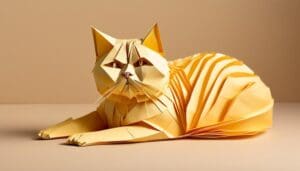As your beloved cat grows older, you may find that typical cat workouts just don’t cut it anymore. Why, you ask? Well, it’s not that your older kitty doesn’t want to stay active and healthy, but rather that their aging bodies may not be up for the usual high-energy antics.
But fear not! There are ways to adapt and tailor exercise routines to suit the needs of your senior cat, ensuring they can still enjoy staying fit and engaged in their golden years.
Key Takeaways
- Aging cats have different exercise needs and abilities compared to younger cats.
- High-impact exercises may be challenging for senior cats due to reduced energy levels and mobility.
- Low-impact exercises, such as gentle play and interactive toys, are beneficial for older cats.
- Consultation with a veterinarian is important for customized exercise regimens and to address any potential health concerns.
Aging Effects on Cat Exercise
As your cat grows older, their exercise needs and abilities change, requiring a more tailored approach to ensure their health and well-being.
Aging effects on cat exercise can impact your older cat’s physical abilities. Older cats may experience reduced energy levels and mobility, making typical cat workouts unsuitable. Health issues such as arthritis can also make it challenging for senior cats to engage in high-impact exercises.
Therefore, it’s essential to understand that cats require appropriate exercise as they age. Instead of high-impact activities, senior cats benefit from low-impact exercises such as gentle play and interactive toys like ball tracks. These activities not only promote a healthy heart but also help delay joint diseases.
Recognize that cats with health concerns, such as arthritis, may require customized exercise regimens tailored to their specific needs. Consulting with a vet is vital to determine the appropriate exercise schedule for older cats with health conditions.
Senior Cat Weight Management
You may have noticed changes in your senior cat’s weight and energy levels. It’s important to consider low-impact exercise options and dietary adjustments to support their weight management.
These changes can help your cat maintain a healthy weight and overall well-being as they age.
Low-Impact Exercise Options
Consider incorporating low-impact exercises into your senior cat’s routine to support weight management and overall health. As your cat ages, their energy levels and mobility decrease, making gentle exercise options essential for maintaining a healthy lifestyle.
Engaging in activities like ball tracks and gentle play not only promotes a healthy heart but also delays the onset of joint diseases in senior cats. Aim for 15-20 minutes of exercise per day, but be mindful of any health concerns such as arthritis, which may require a customized exercise regimen.
Keep in mind that overweight senior cats may need more exercise to manage their weight effectively, so consulting with a vet for a tailored exercise schedule is recommended.
Dietary Adjustments for Seniors
Changing your senior cat’s diet to help manage their weight is very important for their health and happiness. As your cat gets older, their energy and metabolism change, meaning their food needs change too. Making these diet adjustments can keep their weight in check and improve their overall health.
Here are some important considerations to keep in mind:
- Consult your veterinarian for personalized dietary recommendations tailored to your senior cat’s specific needs.
- Choose high-quality, senior-formula cat food that’s lower in calories but still provides essential nutrients.
- Consider smaller, more frequent meals to accommodate your senior cat’s potentially decreased appetite and digestive changes.
- Monitor your cat’s weight and adjust their food intake accordingly to prevent obesity or malnutrition.
These adjustments can make a significant difference in your senior cat’s health and quality of life.
Low-Impact Exercise Benefits
As your beloved cat ages, it’s important to consider low-impact exercises that are gentle on their joints and muscles. These activities can help promote muscle strength and improve flexibility, contributing to their overall well-being.
Gentle on Joints
As a loving cat parent, it’s important to encourage your senior cat to engage in activities that are easy on their joints.
Here’s why gentle exercises are important for older cats:
- Reduced Joint Strain: Low-impact exercises help prevent unnecessary strain on your senior cat’s joints, reducing the risk of discomfort or injury.
- Maintaining Muscle Strength: Gentle activities aid in maintaining muscle strength and mobility, promoting overall well-being in older cats.
- Suitable for Reduced Energy: Low-impact exercises are ideal for senior cats with reduced energy levels, allowing them to stay active without overexerting themselves.
- Delaying Joint Diseases: Engaging in low-impact exercises can help delay the onset of joint diseases, contributing to your older cat’s quality of life.
Considering these benefits supported by Veterinary Medicine, incorporating gentle, joint-friendly exercises into your senior cat’s routine is essential for their health and happiness.
Promotes Muscle Strength
Encouraging gentle, low-impact exercises for your senior cat can play an important role in promoting muscle strength and overall well-being. As cats age, their abilities and limitations change, and it’s essential to ensure they get enough exercise to maintain muscle tone and flexibility.
Low-impact exercises, like gentle stretches and interactive toys, are ideal for promoting muscle strength in older felines. These activities not only help prevent age-related joint diseases but also support a healthy heart in senior cats.
By engaging in these exercises, your cat can improve their quality of life and maintain their independence.
Age-Appropriate Cat Workouts
To ensure your older cat stays healthy and active, it’s important to tailor their workouts to be gentle and low-impact, considering their age and potential health concerns.
Here are some age-appropriate cat workouts to help keep your senior cat in good shape:
- Gentle Play Sessions: Engage your cat in short, gentle play sessions using toys like feather wands or soft balls to encourage movement without putting too much strain on their bodies.
- Interactive Feeding: Incorporate interactive feeding toys that require your cat to move and play in order to access their food. This can provide mental stimulation and light physical activity.
- Low-Impact Exercises: Consider activities like gentle climbing on cat trees, scratching posts, or small, supervised walks to provide exercise without overexerting your cat.
- Regular Vet Check-ups: Ensure your senior cat receives regular check-ups with the vet to monitor their health, weight, and any potential issues that may affect their exercise routine.
Health Considerations for Senior Cats
As your senior cat gets older, it’s important to pay attention to their health needs and limitations regarding exercise and physical activity. Older cats can have health issues like arthritis, less energy, and less mobility, making regular cat exercises not suitable for them. It’s very important to consider these health issues, especially for senior cats that are overweight or have other health problems.
While exercise remains essential for senior cats, it’s important to tailor their workout routines to accommodate their physical limitations and energy levels. Consulting with a vet is essential in determining a customized exercise regimen for senior cats. Vets can consider the cat’s age, overall health, and any specific health conditions to recommend appropriate exercises.
Low-impact activities such as gentle play, interactive toys, and short daily walks can help senior cats stay active without putting strain on their aging bodies. It’s recommended to aim for 15-20 minutes of exercise per day, focusing on activities that promote movement and mental stimulation.
Tailored Exercise Routines for Older Cats
Considering your senior cat’s decreased energy and mobility, it’s important to tailor their exercise routine to promote health and well-being without causing strain. Here’s how you can create a tailored exercise routine for your older cat:
- Low-Impact Activities: Aim for 15-20 minutes of low-impact exercise per day. Activities like ball tracks and gentle exercises can keep your older cat moving without putting excessive strain on their joints.
- Health Concerns: If your cat has health concerns like arthritis, they may only tolerate 15 minutes of movement a day. However, even this minimal exercise can help minimize arthritic pain and strengthen their muscles.
- Weight Management: Overweight older cats may need more exercise to support weight management. Consulting with a vet for a tailored exercise schedule is essential to ensure that the exercise routine is safe and effective for your cat’s specific needs.
- Vet Recommendations: Always seek guidance from a vet to determine the right exercise routine for your older cat. Factors such as age and health condition play an important role in determining the appropriate exercise regimen for your beloved cat.
Exercise Modifications for Elderly Cats
Encourage gentle activities like ball tracks and provide a comfortable environment for them to move around. It’s important to consider any health concerns, such as arthritis, which may limit their movement. Some elderly cats may only tolerate 15 minutes of exercise a day, so consulting with a vet for a tailored exercise schedule is important.
For overweight senior cats, more exercise may be necessary to support weight management, but it should be adjusted to their abilities and limitations. Remember, vet recommendations are important for determining the right exercise routine for elderly cats with various health conditions.
Frequently Asked Questions
Is Exercise Good for Old Cats?
Exercise is essential for old cats. It helps maintain physical and mental fitness, controls weight, and prevents obesity. Encourage play with favorite toys and create a stimulating environment. If you notice changes, consult a vet for investigation.
Can a Cat Be Too Old to Train?
Yes, your cat can be too old to train. Older cats may have reduced energy and mobility, making typical workouts unsuitable. Instead, focus on low-impact exercises tailored to their specific needs to keep them healthy and happy.
How Do You Train a Senior Cat?
To train a senior cat, focus on low-impact exercises like ball tracks and gentle play for 15-20 minutes daily. Tailor workouts to any health concerns, like arthritis, and consult your vet for a customized regimen, ensuring your cat’s comfort and fitness.
How Do I Get My Senior Cat to Exercise?
Encouraging your senior cat to exercise can be a gentle process. Utilize their favorite toys and healthy treats to motivate play. Consider creating a cat obstacle course and making small changes to stimulate activity.




